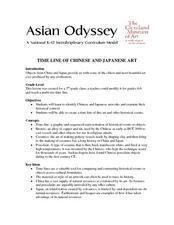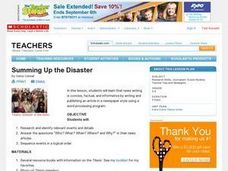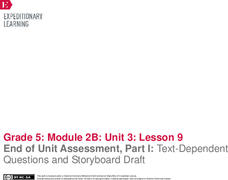Curated OER
Michigan's Early History
Students use maps and lecture notes to discover the diverse history of the state of Michigan. After gathering their information, students develop interview questions that might be used to interview an elderly person in their community.
Curated OER
Cultural Inquiry Lesson 2B: Finding Artifacts and Analysis
Students build on their knowledge of sources, by looking at 2 types of information sources: artifacts or primary sources and analysis or secondary sources. They brainstorm a list of primary and secondary sources connected to one of...
Curated OER
Mercer Mayer 2: Peer Experts Teach Kispiration
Students observe a model classroom of cooperative groups in action. After the video, students discuss how to organize the classroom to promote cooperative learning. They examine the difficulties in allowing students to work in small groups.
Curated OER
Air: You Can't See It, But It's There!
First graders investigate that air occupies space by performing experiments that show this principle. Students are provided with a lunch bag. Students open the lunch bag and look inside. Students determine if there is anything in their...
Curated OER
"Stone Fox" Chapter 7
In this comprehension worksheet, learners answer a set of 7 multiple choice questions covering chapter 7 of Stone Fox. An answer key is included.
Curated OER
Resources of the Three Little Pigs
Second graders, after listening to the The Three Little Pigs, identify the natural, human, and capital resources involved in creating each house.
Curated OER
Apply Technological Design and Scientific Habits of Mind
Students are introduced to the principles involved with technological design. In groups, they use the Internet to research an important historical innovation and how it changed the world. They discover the barriers that were involved in...
Curated OER
Scavenger Hunt
Students search for items in various parts of the newspaper noting the different types of information it provides.
Curated OER
Speaking Out For Women's Rights
Students write a children's story in which the characters are encouraged to speak out for the equality of women. They create a character and plot outline that includes details and supporting statements for women's rights. A brief 2-3...
Curated OER
Biology: Howler Monkeys Tell All
Students examine a PBS special about howler monkeys as an introduction to scientific forensic investigative methods. In groups, they conduct a host of experiments containing clues which point to discovery. By challenging assumptions,...
Curated OER
SNACK TIME
Students explore writing sequential information by composing the simple recipe of peanut buttera and jelly sandwiches.
Curated OER
World War II Time Line
Young scholars locate information on WWII in reference books. They as a group place key events of WWII in appropriate sequence on a time line and discuss key events that occurred during WWII as a class.
Pennsylvania Department of Education
Giving Things a Name
Young scholars label images seen on an interactive website. In this early writing lesson, students do their best to write the name of the object seen on the screen.
Curated OER
Time Line Of Chinese And Japanese Art
Students create individual time lines placing various works of Asian art into chronological order. The information gathered is used to create one class time line for display.
Curated OER
Historical Figures
Student research a "Historical Individual" using the Internet. They print a minimum of five articles and organize them. They create a visual biography of their historical figure.
Curated OER
Ozone Pollution: Smog Alert
Pupils explain ozone pollution and make them aware of how it is formed. They simulate the development of smog and infer how it occurs in nature.
Curated OER
Exhibiting Your Knowledge
Young scholars are introduced to the various museum functions. In groups, they create a traveling exhibition based on Gutenberg's invention and the first printed book. They share their exhibition with the class and answer any questions...
Curated OER
Memories, A Connection to the Past
Third graders read four books related to the past and memories. With a partner, they complete a graphic organizer for each story in English or Spanish. To end the lesson plan, they write a short paper summarizing the material and...
Curated OER
Stretch to the Math Tables
Students count by multiples while performing stretches or exercises. They listen to music and skip count by a given multiple. The rhythm of the music as well as the repitition assists them in their memorization of multiplication facts.
Florida Center for Reading Research
Comprehension: Narrative Text Structure, Story Pieces
An activity boosts reading comprehension by challenging scholars to answer questions about a narrative tale detailing elements—plot, characters, setting, theme, problem, and solution.
Curated OER
Summing the Disaster
Students assume the role of a newspaper editor during the time of the Titanic disaster. They must search out the accurate answers to the questions: What? When? Where? Who? and Why? students then write their own newspaper article...
Curated OER
Left-to-Right Reading
Left-to-right, left-to-right, that's the way we read and write! Watch this short video clip and teach your young learners this chant before they start writing!
EngageNY
End of Unit Assessment, Part 1: Text-Dependent Questions and Storyboard Draft: “You Can Do a Graphic Novel” Excerpt
Eyes on the finish line. Serving as the first part of the end of unit assessment, learners answer questions based on a text about how to write a graphic novel. Using what they've learned, they then create a storyboard about the invention...
Shmoop
ELA.CCSS.ELA-Literacy.RL.11-12.3
Identifying an author’s choice, especially choices that concern craft and literary devices, is a difficult skill to teach. Here's an activity that will make your job easier. The resource breaks down how to teach the skill to novice,...

























